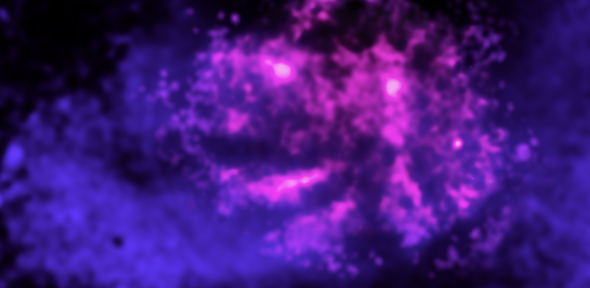
Astronomers have discovered enormous smooth shapes that look like vapour trails in a gigantic galaxy cluster. These ‘arms’ span half a million light years and provide researchers with clues to a billion years of collisions within the “giant cosmic train wreck” of the Coma cluster.
Astronomers have discovered enormous smooth shapes that look like vapour trails in a gigantic galaxy cluster. These ‘arms’ span half a million light years and provide researchers with clues to a billion years of collisions within the “giant cosmic train wreck” of the Coma cluster.
Coma is like a giant cosmic train wreck where several clusters have collided with each other. We hadn’t expected that these rather delicate straight filaments would survive in that environment
Jeremy Sanders
Unusual gas filament ‘arms’ have been found in the central region of the Coma cluster, a large collection of thousands of galaxies located about 300 million light years from Earth - and one of the largest structures in the Universe held together by gravity.
These remarkably long arms – which bear resemblance to vast galactic vapour trails - glow in X-ray light, and tell astronomers about the collisions that took place between Coma and other galaxy clusters over the last billion years.
A team of astronomers from Cambridge and the Max Planck Institute discovered the enormous X-ray vapour trails – spanning at least half a million light years – in Coma by using data from NASA’s Chandra X-ray Observatory as well as ESA’s XMM-Newton. The elongated filaments of hot gas were revealed after enhancing the detail in Chandra X-ray images, shown in purple above.
Researchers think that these arms were most likely formed when smaller galaxy clusters had their hot gas stripped away while merging with the larger Coma cluster. This would have left a trail of superheated gas behind them similar to a jet leaving behind trails of water vapour as it moves across the sky.
Coma is an unusual galaxy cluster because it contains not one, but two giant elliptical galaxies near its centre. These two giant elliptical galaxies are probably the trace remains of each of the two largest galaxies that merged with Coma in the past. There are also other signs of past collisions and mergers that the researchers were able to uncover in the data.
The newly discovered X-ray arms are thought to be about 300 million years old, and they appear to have a rather smooth shape. This gives researchers some clues about the conditions of the hot gas in Coma. Most theoretical models expect that mergers between clusters like those in Coma will produce strong turbulence, like ocean water that has been churned by passing ships. Instead, the smooth shape of these lengthy arms points to a rather calm setting for the hot gas in the Coma cluster, even after many mergers.
“Coma is like a giant cosmic train wreck where several clusters have collided with each other. We hadn’t expected that these rather delicate straight filaments would survive in that environment,” said lead author Dr Jeremy Sanders, who conducted much of the research whilst at Cambridge’s Institute of Astronomy alongside Professor Andrew Fabian.
“The existence of these long straight structures appears to point towards the centre of the Coma cluster being a much calmer environment than we had expected.”

Elongated structures of hot gas found after enhancing the detail in images taken with the Chandra (pink) and on larger scales XMM-Newton (purple) X-ray observatories
Two of the arms appear to be connected to a group of galaxies located about two million light years from the centre of Coma. One or both of the arms connects to a larger structure seen in the XMM-Newton data, and spans a distance of at least 1.5 million light years. A very thin tail also appears behind one of the galaxies in Coma. This is probably evidence of gas being stripped from a single galaxy, in addition to the groups or clusters that have merged there.
Galaxy clusters are the largest objects held together by gravity in the universe. The collisions and mergers between galaxy clusters of similar mass are the most energetic events in the nearby universe. These new results are important for understanding the physics of these enormous objects and how they grow.
Large-scale magnetic fields are likely responsible for the small amount of turbulence that is present in Coma. Estimating the amount of turbulence in a galaxy cluster has been a challenging problem for astrophysicists. Researchers have found a range of answers, some of them conflicting, and so observations of other clusters are needed.
These new results on the Coma cluster, which incorporate over six days worth of Chandra observing time, appears in the latest issue of the journal Science.
Text adapted from a NASA Chandra press release
This work is licensed under a Creative Commons Licence. If you use this content on your site please link back to this page.





